Anforderungen an die Hygiene bei der Auf - Deutsche Gesellschaft ...
Anforderungen an die Hygiene bei der Auf - Deutsche Gesellschaft ...
Anforderungen an die Hygiene bei der Auf - Deutsche Gesellschaft ...
Erfolgreiche ePaper selbst erstellen
Machen Sie aus Ihren PDF Publikationen ein blätterbares Flipbook mit unserer einzigartigen Google optimierten e-Paper Software.
24<br />
Empfehlung <strong>der</strong> Kommission für Kr<strong>an</strong>kenhaushygiene und Infektionsprävention <strong>bei</strong>m Robert Koch-Institut (RKI)<br />
Recommendation of the Commission for Hospital <strong>Hygiene</strong> <strong>an</strong>d Infection Prevention at the Robert Koch Institute (RKI)<br />
• Alle K<strong>an</strong>äle mit Luft durchblasen, um Flüssigkeitsreste<br />
zu entfernen.<br />
3 Abspülen <strong>der</strong> Reinigungslösung<br />
• Gereinigte Zusatzinstrumente in Becken mit sauberem<br />
Leitungswasser einlegen, zu jedem Spülvorg<strong>an</strong>g<br />
frisches Leitungswasser verwenden.<br />
• Alle K<strong>an</strong>äle vollständig und gründlich mit Wasser<br />
spülen.<br />
• Außenflächen <strong>der</strong> Instrumente gründlich mit Leitungswasser<br />
abspülen.<br />
• Instrumentarium aus dem Wasser entnehmen.<br />
• Alle K<strong>an</strong>äle mit Luft durchblasen, um Spülwasserreste<br />
zu entfernen.<br />
4 Desinfektion<br />
• Gereinigtes Instrumentarium in W<strong>an</strong>ne mit Desinfektionsmittellösung<br />
einlegen.<br />
• Alle K<strong>an</strong>äle/Lumina luftblasenfrei mit Desinfektionsmittellösung<br />
füllen.<br />
• W<strong>an</strong>ne mit zugehörigem Deckel abdecken.<br />
• Konzentration und Einwirkzeit des Desinfektionsmittels<br />
gemäß Hersteller<strong>an</strong>gaben einhalten.<br />
• Instrumente/Instrumententeile mit frischen Einmalh<strong>an</strong>dschuhen<br />
aus <strong>der</strong> Desinfektionsmittellösung<br />
entnehmen.<br />
5 Neutralisation/Klarspülung<br />
• Desinfiziertes Zusatzinstrumentarium in Becken/<br />
W<strong>an</strong>ne mit mikrobiologisch einw<strong>an</strong>dfreiem/sterilem<br />
Wasser einlegen, für jedes Instrumentarium frisches<br />
Wasser verwenden.<br />
• Außenflächen <strong>der</strong> Instrumente und alle K<strong>an</strong>äle<br />
gründlich mit Wasser spülen, um Desinfektionsmittelrückstände<br />
zu entfernen.<br />
• Instrumentarium aus dem Wasser entnehmen.<br />
6 Trocknung und Funktionsprüfung<br />
• Äußere Oberflächen mit flusenfreiem Tuch und mit<br />
Druckluft trocknen.<br />
• Alle K<strong>an</strong>äle vollständig mit Druckluft trocknen.<br />
• Instrumente zusammensetzen und auf korrekte<br />
Funktion überprüfen.<br />
7 Sterilisation<br />
• Instrumente in geeignete Sterilgutverpackung geben.<br />
• Das geeignete Sterilisationsverfahren für thermisch<br />
stabile bzw. thermisch instabile Instrumente gemäß<br />
den Hersteller<strong>an</strong>weisungen und den nationalen<br />
gesetzlichen Bestimmungen und Empfehlungen<br />
auswählen (empfohlen wird: Dampf-Sterilisation im<br />
Sterilisator) [38].<br />
• Nach <strong>der</strong> Sterilisation Sterilgutverpackung auf Schäden<br />
überprüfen, Sterilisationsindikatoren überprüfen.<br />
8 Lagerung<br />
• Sterilisierte Instrumente in Sterilgutverpackung in<br />
einem geschlossenen Schr<strong>an</strong>k, geschützt vor Staub,<br />
Feuchtigkeit und Temperaturschw<strong>an</strong>kungen lagern.<br />
• Air-purge all ch<strong>an</strong>nels to remove liquid residues.<br />
3 Rinsing Off the Cle<strong>an</strong>ing Solution<br />
• Place cle<strong>an</strong>ed accessories in a basin containing<br />
cle<strong>an</strong> tap water; use fresh tap water for each rinsing<br />
cycle.<br />
• Completely <strong>an</strong>d thoroughly flush all ch<strong>an</strong>nels with<br />
water.<br />
• Rinse off outsides of the instruments thoroughly<br />
using tap water.<br />
• Remove instruments from the water.<br />
• Air-purge all ch<strong>an</strong>nels to remove rinse water residues.<br />
4 Disinfection<br />
• Place cle<strong>an</strong>ed instruments in a tray containing disinfect<strong>an</strong>t<br />
solution.<br />
• Fill all ch<strong>an</strong>nels/lumina with disinfect<strong>an</strong>t solution in<br />
such a way that no air bubbles are formed.<br />
• Cover tray with the appropriate lid.<br />
• Observe concentration <strong>an</strong>d contact time of the disinfect<strong>an</strong>t<br />
as per m<strong>an</strong>ufacturer‘s instructions.<br />
• Remove instruments/instrument components from<br />
the disinfect<strong>an</strong>t solution with fresh disposable<br />
gloves.<br />
5 Neutralisation/Clear Rinsing<br />
• Place disinfected accessories in basin/tray containing<br />
microbiologically impeccable/sterile water; use<br />
fresh water for each instrument.<br />
• Rinse the outsides of the instruments <strong>an</strong>d all ch<strong>an</strong>nels<br />
with water thoroughly to remove disinfect<strong>an</strong>t<br />
residues.<br />
• Remove instruments from the water.<br />
6 Drying <strong>an</strong>d Function Testing<br />
• Dry outer surfaces with a lint-free cloth <strong>an</strong>d with<br />
compressed air.<br />
• Dry all ch<strong>an</strong>nels thoroughly with compresssed air.<br />
• Assemble instruments <strong>an</strong>d check they function correctly.<br />
7 Sterilisation<br />
• Wrap instruments in adequate sterile goods packaging.<br />
• Select the right sterilisation method for thermally<br />
stable <strong>an</strong>d/or thermally unstable instruments as per<br />
m<strong>an</strong>ufacturer‘s instructions <strong>an</strong>d the national legal<br />
provisions <strong>an</strong>d recommendations (vapour sterilisation<br />
in the steriliser is recommended) [38].<br />
• After sterilisation, check sterile goods packaging for<br />
damage, check sterilisation indicators.<br />
8 Storage<br />
• Store sterilised instruments in sterile goods packaging<br />
in a closed cabinet <strong>an</strong>d protected against dust,<br />
moisture <strong>an</strong>d variations in temperature.<br />
Erstmalig veröffentlicht in Bundesgesundheitsbl Gesundheitsforsch – Gesundheitsschutz | first published in Fe<strong>der</strong>al Health Gazette Health Research – Health Protection<br />
2002 • 45:395–411 © Springer-Verlag 2002



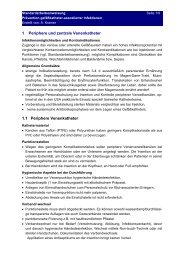
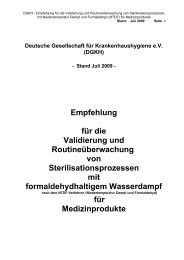


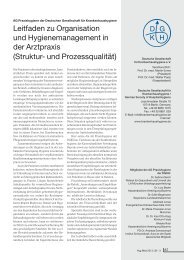
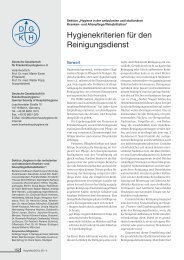


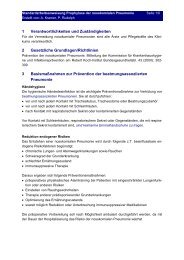


![Hauptprogramm [A4-Quer] - Deutsche Gesellschaft für ...](https://img.yumpu.com/6449478/1/184x260/hauptprogramm-a4-quer-deutsche-gesellschaft-fur-.jpg?quality=85)
